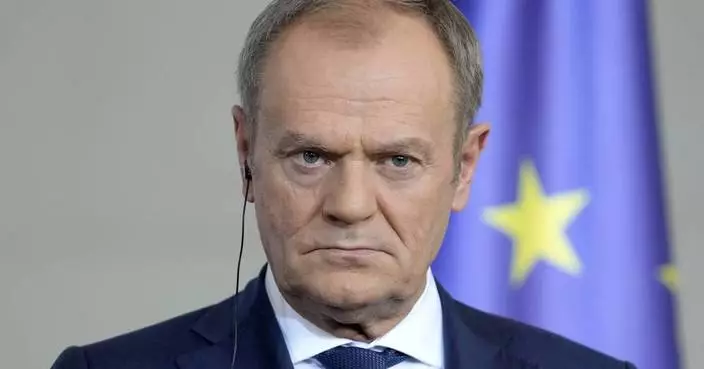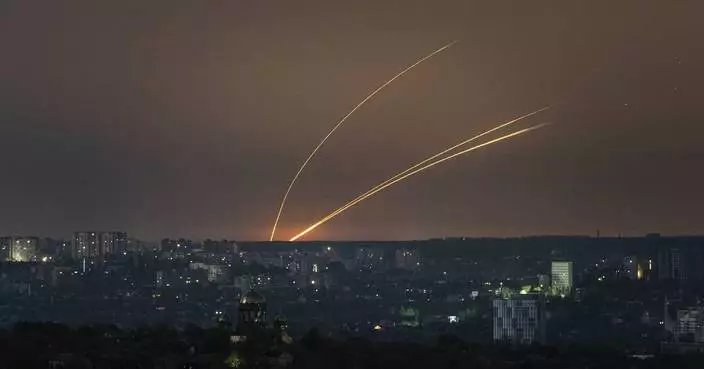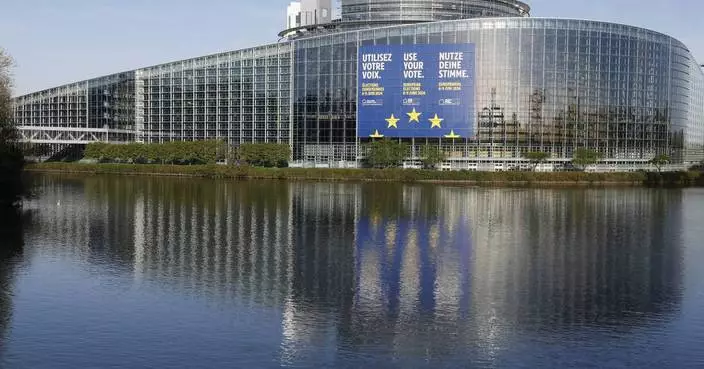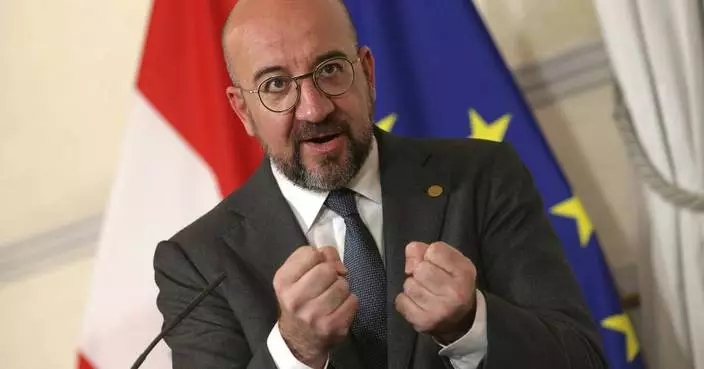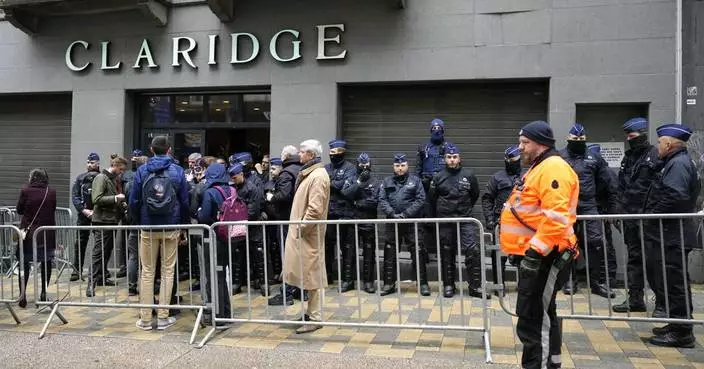The golden angel once glimmered majestically from Notre Dame's vault.
Now, with a broken nose, chipped gold-leaf and a smashed bust, it stares up blankly at a warehouse roof in the outskirts of Paris where blackened fragments of the famed cathedral's stained glass mingle with organ pipes and jagged vault stones.
Click to Gallery
The golden angel once glimmered majestically from Notre Dame's vault.
Debris is still falling from Notre Dame's roof as fears over dust poisoning from the cathedral's burnt-out lead roof has frightened the people of Paris and a spring 2020 deadline looms for a major diagnostic report on how to fix the lab's most famous patient.
One key question the scientists are trying to establish is how damaged the remaining stone is, after being not only burnt but then doused in water from firefighters.
Although Notre Dame's two medieval towers were spared from collapsing in the fire that destroyed the cathedral's roof and spire, he warned that the stone in the French Gothic masterpiece is still not out of danger.
"If the stone was going to collapse, it would have collapsed already. But it does need serious help," he added.
"It's a tricky subject, because the Notre Dame quarries no longer exist... Where are we going to find them?" Magnien asked.
Like the setting, their work has one foot in the future and one in the past.
It dawned on them that the "medieval engineers might have built in a fire safety system to slow down any potential fire," Mertz said with a beaming smile.
Scientists at the French government's Historical Monuments Research Laboratory are using these objects as clues in an urgent and vital task: Working out how to safely restore the beloved Paris cathedral and identify what perils remain inside the monument in a race against the clock.

In this photo taken on Wednesday, Oct. 9, 2019, stone expert Jean-Didier Mertz, gestures next to the remain of the golden angel that was once atop Notre Dame cathedral, in a warehouse at Champs-sur-Marne, west of Paris. Scientists at the French government's Historical Monuments Research Laboratory are using these objects as clues in an urgent and vital task, working out how to safely restore the beloved Paris cathedral and identify what perils remain inside in a race against the clock. (AP PhotoFrancois Mori)
Debris is still falling from Notre Dame's roof as fears over dust poisoning from the cathedral's burnt-out lead roof has frightened the people of Paris and a spring 2020 deadline looms for a major diagnostic report on how to fix the lab's most famous patient.
"For the moment, the cathedral is in an emergency state of peril... It's still falling, stones fall regularly," said Aline Magnien, the lab director. "Fifteen to 20 (scientists) have been working at Notre Dame, notably to filter out the rubble. Everything that fell from the roof vaults — the wood, the metal, the stone — has been the object of a sort of archaeological excavation."
The April 15 inferno has turned the lab in the sleepy town of Champs-sur-Marne into a hive of activity, with geologists, microbiologists and experts in metal and stained glass manning laser beams, microscopes and state-of-the-art computer technology to analyze key pieces of debris — work that goes on often until midnight.
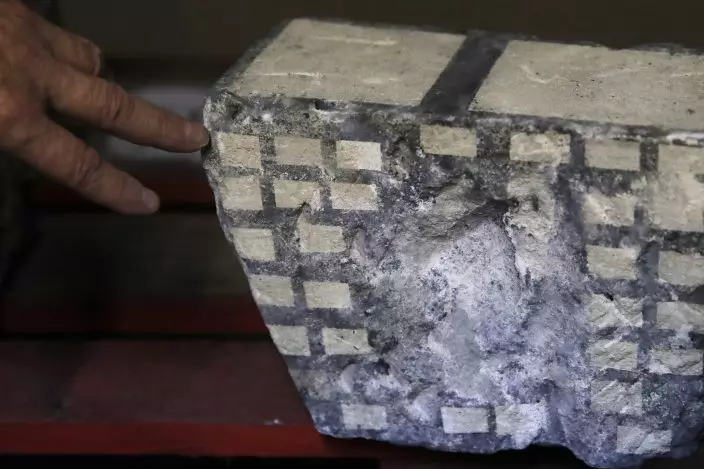
In this photo taken on Wednesday, Oct. 9, 2019, stone expert Jean-Didier Mertz shows the tests of laser cleaning technique on a broken vault stone from Notre Dame cathedral in a warehouse at Champs-sur-Marne, west of Paris. Scientists at the French government's Historical Monuments Research Laboratory are using these objects as clues in an urgent and vital task, working out how to safely restore the beloved Paris cathedral and identify what perils remain inside in a race against the clock. (AP PhotoFrancois Mori)
One key question the scientists are trying to establish is how damaged the remaining stone is, after being not only burnt but then doused in water from firefighters.
Architects need to know how strong the stone is to know how heavy the cathedral's new roof and spire can be — without risking further calamity.
The lab's stone expert, Jean-Didier Mertz, proudly showed off his myriad machines, glass atriums and vault stones wrapped in kitchen cling-film. He said Notre Dame's stone could have been weakened by up to 50% because of water that caused it to expand in a close-knit stone structure that has little natural breathing room.
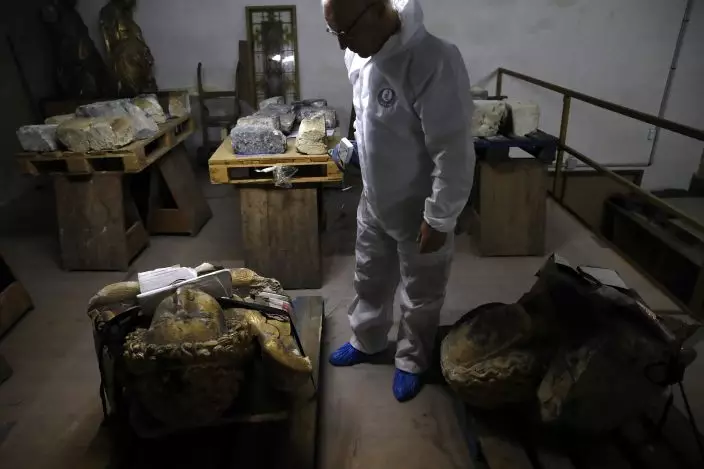
In this photo taken on Wednesday, Oct. 9, 2019, stone expert Jean-Didier Mertz, looks on next to the remains of the golden angel that was once atop Notre Dame cathedral, in a warehouse at Champs-sur-Marne, west of Paris. Scientists at the French government's Historical Monuments Research Laboratory are using these objects as clues in an urgent and vital task, working out how to safely restore the beloved Paris cathedral and identify what perils remain inside in a race against the clock. (AP PhotoFrancois Mori)
Although Notre Dame's two medieval towers were spared from collapsing in the fire that destroyed the cathedral's roof and spire, he warned that the stone in the French Gothic masterpiece is still not out of danger.
"Since the construction and (architect) Viollet-le-Duc's revamp in 1864, the stones haven't seen a single drop of water," he explained. "The fact there was the fire and water to extinguish it totally changed the material's surface."
Even though debris is still falling down at the cathedral, Mertz said he did not think the remaining stone structure would come down.
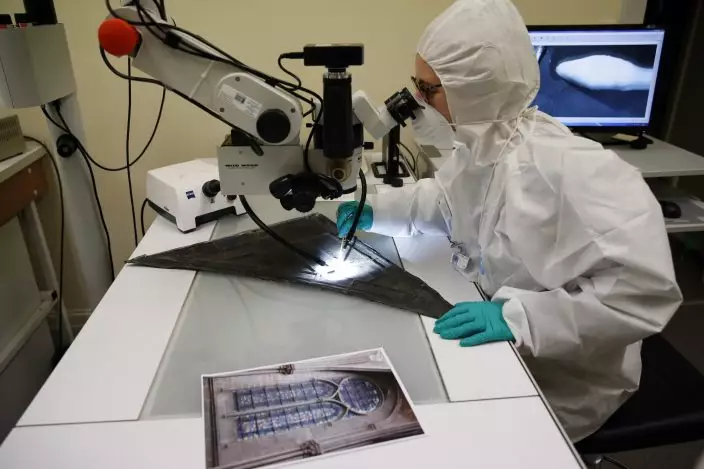
In this photo taken on Wednesday, Oct. 9, 2019, Glass specialist Claudine Loisel checks the Notre Dame cathedral's stained-glass windows in a lab at Champs-sur-Marne, west of Paris. Scientists at the French government's Historical Monuments Research Laboratory are using these objects as clues in an urgent and vital task, working out how to safely restore the beloved Paris cathedral and identify what perils remain inside in a race against the clock. (AP PhotoFrancois Mori)
"If the stone was going to collapse, it would have collapsed already. But it does need serious help," he added.
He says he will recommend using a stone-hardening liquid coating on the surface of the stones. For stones with fissures, he says a mortar mix will be used to fill the holes.
Officials at the lab currently estimate 500 cubic meters of stone will be required to rebuild parts of the church.

In this photo taken on Wednesday, Oct. 9, 2019, Glass specialist Claudine Loisel checks the Notre Dame cathedral's stained-glass windows in a lab at Champs-sur-Marne, west of Paris. Scientists at the French government's Historical Monuments Research Laboratory are using these objects as clues in an urgent and vital task, working out how to safely restore the beloved Paris cathedral and identify what perils remain inside in a race against the clock. (AP PhotoFrancois Mori)
"It's a tricky subject, because the Notre Dame quarries no longer exist... Where are we going to find them?" Magnien asked.
The lab combines high tech with a typically Gallic environment.
Located inside the Champs-sur-Marne chateau, the team of scientists wearing plastic aprons, elasticated shoe covers and respiratory masks crack jokes amid the turreted 18th-century architecture.
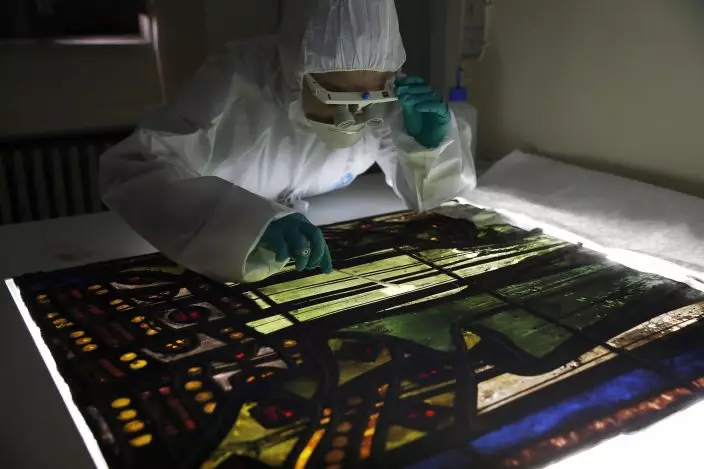
In this photo taken on Wednesday, Oct. 9, 2019, Glass specialist Claudine Loisel checks the Notre Dame cathedral's stained-glass windows in a lab at Champs-sur-Marne, west of Paris. Scientists at the French government's Historical Monuments Research Laboratory are using these objects as clues in an urgent and vital task, working out how to safely restore the beloved Paris cathedral and identify what perils remain inside in a race against the clock. (AP PhotoFrancois Mori)
Like the setting, their work has one foot in the future and one in the past.
Their analysis of the previously unseen historic debris has ended up revealing secrets about the cathedral and the incredible talents of the medieval architects who designed it.
A small layer of plaster found on the cathedral's fallen vault stones initially confounded the lab's experts, given that plaster is an insulating material and not a glue-like mortar that would have normally held the stones together.
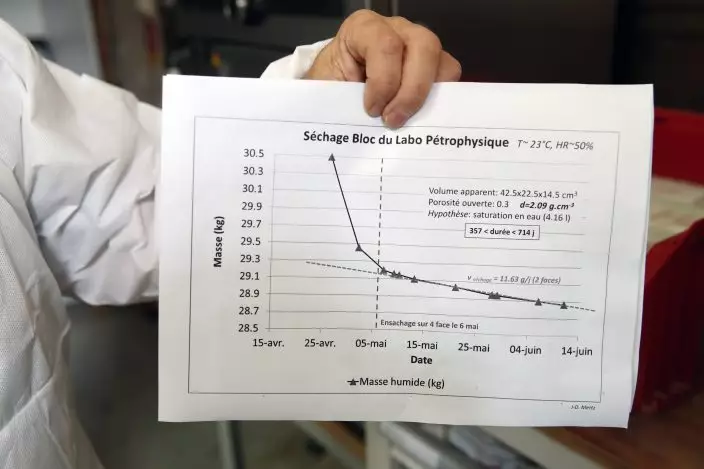
In this photo taken on Wednesday, Oct. 9, 2019, stone expert Jean-Didier Mertz, displays his measure of the drying time for a stone from Notre Dame cathedral, in a lab at Champs-sur-Marne, west of Paris. Scientists at the French government's Historical Monuments Research Laboratory are using these objects as clues in an urgent and vital task, working out how to safely restore the beloved Paris cathedral and identify what perils remain inside in a race against the clock. (AP PhotoFrancois Mori)
It dawned on them that the "medieval engineers might have built in a fire safety system to slow down any potential fire," Mertz said with a beaming smile.
The scientists also complimented the skills of modern-day fire experts.
Glass specialist Claudine Loisel explained how Notre Dame's stained-glass windows were saved by the skill of the French firefighters who'd learned the lessons of 1984 blaze at York Minster in northern England. They didn't douse the windows with water, Loisel said, and only gently sprinkled the surrounding area, thus preventing the glass from exploding.

In this photo taken on Wednesday, Oct. 9, 2019, stone expert Jean-Didier Mertz displays a broken vault stone from Notre Dame cathedral in a warehouse at Champs-sur-Marne, west of Paris. Scientists at the French government's Historical Monuments Research Laboratory are using these objects as clues in an urgent and vital task, working out how to safely restore the beloved Paris cathedral and identify what perils remain inside in a race against the clock. (AP PhotoFrancois Mori)
Loisel, like others on her team, talks of Notre Dame like a doctor would of a sick patient.
"The stained-glass windows are in good shape. We have some pathologies, we might have some breakages from time to time, linked to thermal shock," she explained as she gently cleaned a window fragment from cathedral's east wing. "But in contrast to what we could have imagined, we have hardly anything."
Another key question is the cathedral's lead.
The blaze burnt up an estimated 200 tons of lead, a key material in its 19th-century roof, some of which went far into the Paris atmosphere.
After the fire, high levels of lead were recorded in the immediate neighborhood and in the blood of some local children. The massive cleanup inside the cathedral itself was briefly suspended until special protection measures for workers were put into place.
Aurelia Azema, Metals chief at the Historical Monuments Research Laboratory, said her job was to not only advise on how to clean the cathedral without damaging the original materials, but to create a lead "fingerprint" to know where lead that the fire spat out landed beyond the building's walls.
"Knowing that digital fingerprint of the cathedral, we will be able to compare it will the lead that went into the atmosphere and to know (if) the traces we have found in Paris match the lead that was in the cathedral," she said.
French President Emmanuel Macron made an ambitious pledge shortly after the catastrophe that Notre Dame would be rebuilt by 2024, enlisting 71-year-old former army chief Jean-Louis Georgelin to crack the whip. The tight timeline has prompted widespread disbelief among architects, renovation experts and others, including some of the lab's employees.
When asked about how the restorers plan to finish such an extensive restoration in just five years, the lab's deputy director shrugged his shoulders.
"We have a general for that," Magnien said with a smile.
Follow Thomas Adamson at https://twitter.com/ThomasAdamson_K
PARIS (AP) — French President Emmanuel Macron warned Thursday that Europe could “die” if it fails to build its own robust defense as Russia’s war in Ukraine rages on, or if it fails to undertake major trade and economic reforms to compete with China and the U.S.
Macron urged Europeans to become more ambitious in a fast-changing world to face the challenges of war, fierce trade competition, energy scarcity, climate change and increasing authoritarianism.
In a nearly two-hour speech at Sorbonne University in Paris, Macron said that the continent is divided and “too slow and lacks ambition” at a time when the 27-member European Union needs to become a superpower, defend its own borders and speak with one voice if it wants to survive and thrive.
“Our Europe today is mortal,” Macron said. “It can die and that depends solely on our choices,” he added. He called on people to make those choices now because, “it’s today that Europe is between war and peace.”
Russia's full-scale invasion of Ukraine, now in its third year, is an existential threat and Europe isn't armed enough to defend itself when “confronted by a power like Russia that has no inhibitions, no limits,” Macron said.
‘Our ability to ensure our security is at stake," Macron said. “Russia mustn’t be allowed to win.”
Europe now has the “good fortune” of having the Biden administration’s commitment to supporting Ukraine, Macron said. But, in a year of key elections around Europe, in the U.S. and elsewhere, support may fragment or disappear entirely, he added.
“Europe must become capable of defending its interests, with its allies by our side whenever they are willing, and alone if necessary,” Macron said.
Strong armies, a European rapid intervention program and force, tanks, a missile shield and other weapons, produced in Europe, will need the support of “a joint diplomatic force that will speak with one voice and build bridges with Africa and Latin America,” the French leader said.
“Only then will Europe show that it's not a United States’ lap dog, and that it also knows how to talk to other regions of the world,” he said.
France has been a firm supporter of Ukraine in its fight against Russian aggression, and Macron has often clashed with other Western leaders as he has insisted that Europe must stand by the country at any cost. The French president alarmed European leaders by saying recently that sending Western troops into Ukraine to shore up its defenses shouldn’t be ruled out.
Referring to trade practices of China and the U.S., Macron said “the two world powers have decided not to respect the rules of global trade” by shoring up protections and subsides while Europe’s industry remains open and is stuck in overregulation.
“Let’s do the same, we are in competition,” Macron said.
“We must buy faster, we must produce more and we must buy more that is made in Europe. That is key,” Macron said.
Thursday's speech came less than two months before a pivotal European Parliament election.
Macron, an avid advocate of a united and assertive Europe, also rallied support for his centrist Renaissance party before the June 6-9 vote as far-right parties lead the moderate coalitions in the polls. He called for safeguarding democratic values as the “authoritarian model” was becoming “more popular” across the continent.
The war in Ukraine and immigration are top priorities for European Union voters, according to polls. Far-right parties have gained support by criticizing Macron’s government policies on both issues. Macron acknowledged divisions on immigration policies, including on asylum and deportation rules for those who have arrived to Europe illegally.
He emphasized the need for an effective response and Europe-wide coordination for curbing illegal immigration, closer cooperation with immigrants' countries of origin and a unified, relentless fight against human traffickers.
Macron criticized the idea of striking an agreement, as Britain as done, with countries in Africa and elsewhere to transfer immigrants there.
“This is a betrayal of our values that ultimately leads us to dependency on other counties,” Macron said.
The British government earlier this week approved a law allowing the deportation of some migrants who enter the country illegally to Rwanda.
Macron lost his majority in France’s most influential house of parliament, the National Assembly, after the 2022 election to the far-left coalition and the far-right National Rally party.
The social situation in France remains tense as Paris prepares to host the Olympic Games this summer, amid protests from teachers and police officers, and farmer demonstrations in recent weeks. The protests follow huge rallies last year against Macron’s ultimately successful proposal to increase the retirement age from 62 to 64.
Barbara Surk reported from Nice, France. Lorne Cook contributed to this report from Brussels.
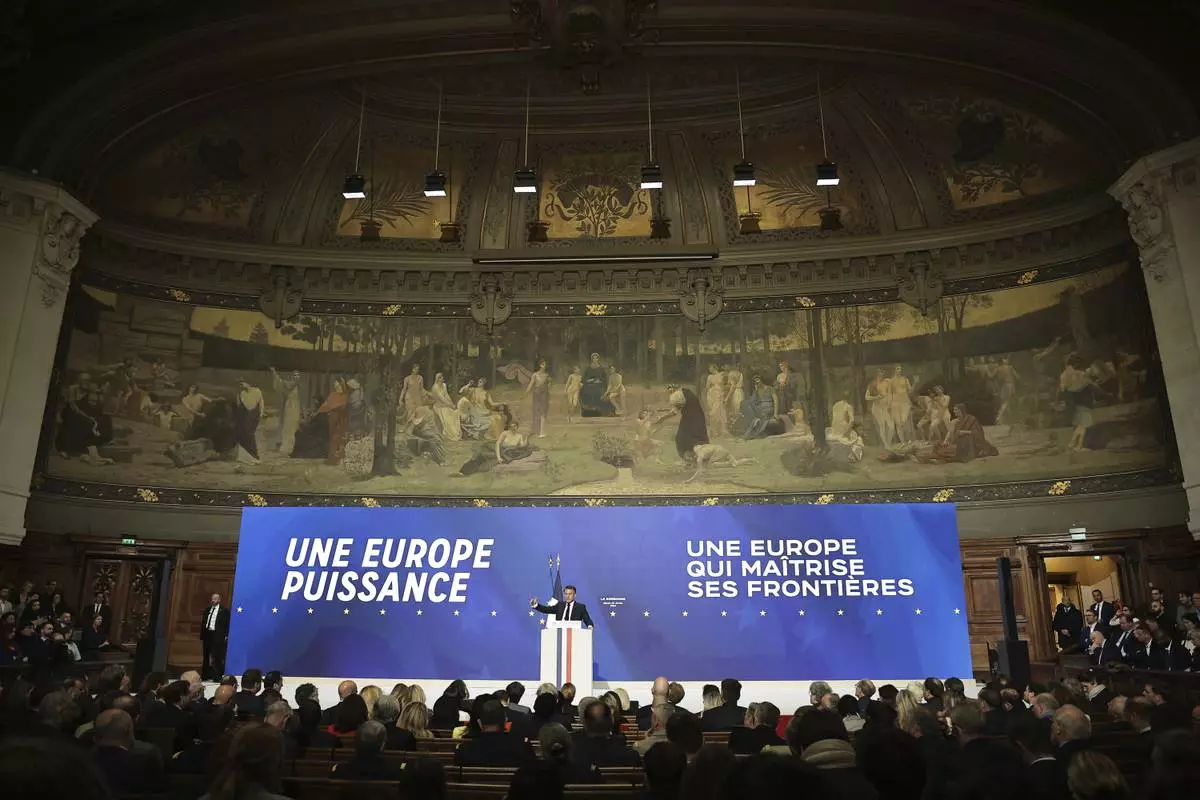
French President Emmanuel Macron delivers a speech on Europe in the amphitheater of the Sorbonne University, Thursday, April 25 in Paris. 2024. French President Emmanuel Macron will outline his vision for Europe as a more assertive global power at the backdrop of war in Ukraine, security, and economic challenges in a speech ahead of pivotal election for the European Parliament in June. (Christophe Petit Tesson, Pool via AP)
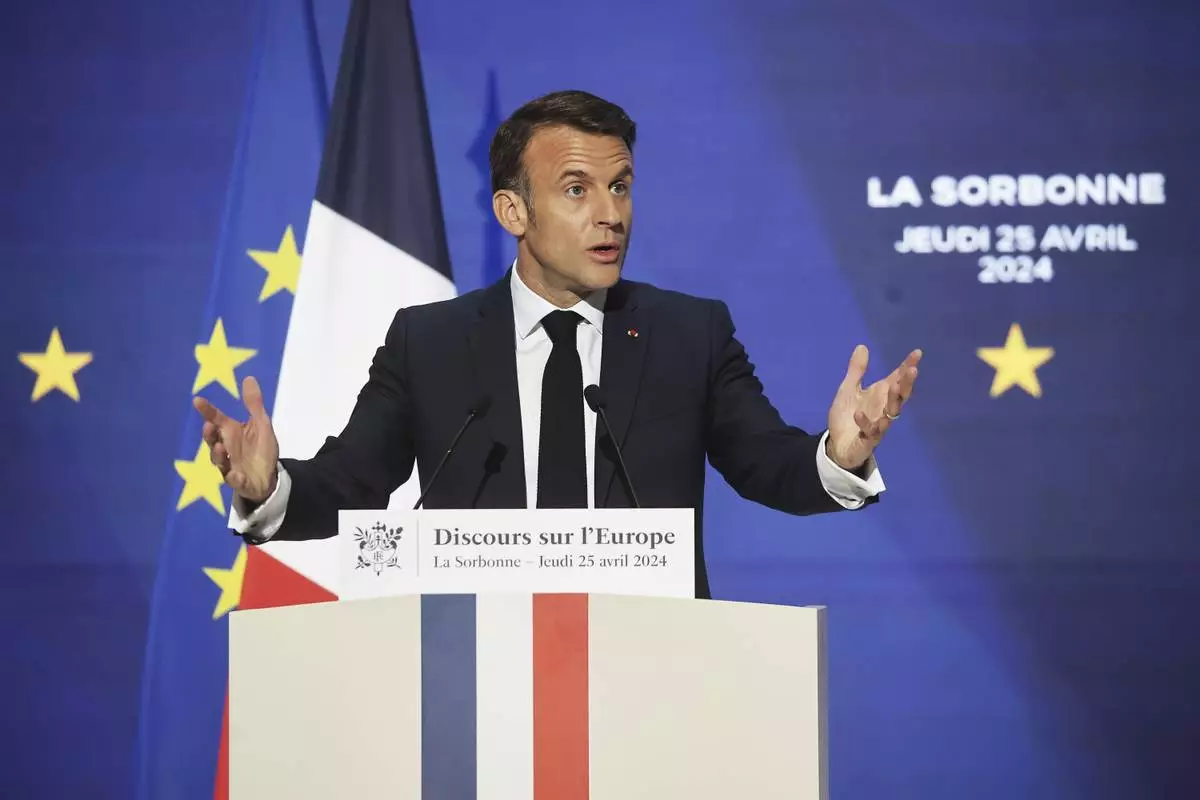
French President Emmanuel Macron delivers a speech on Europe in the amphitheater of the Sorbonne University, Thursday, April 25 in Paris. 2024. French President Emmanuel Macron will outline his vision for Europe as a more assertive global power at the backdrop of war in Ukraine, security, and economic challenges in a speech ahead of pivotal election for the European Parliament in June. (Christophe Petit Tesson, Pool via AP)
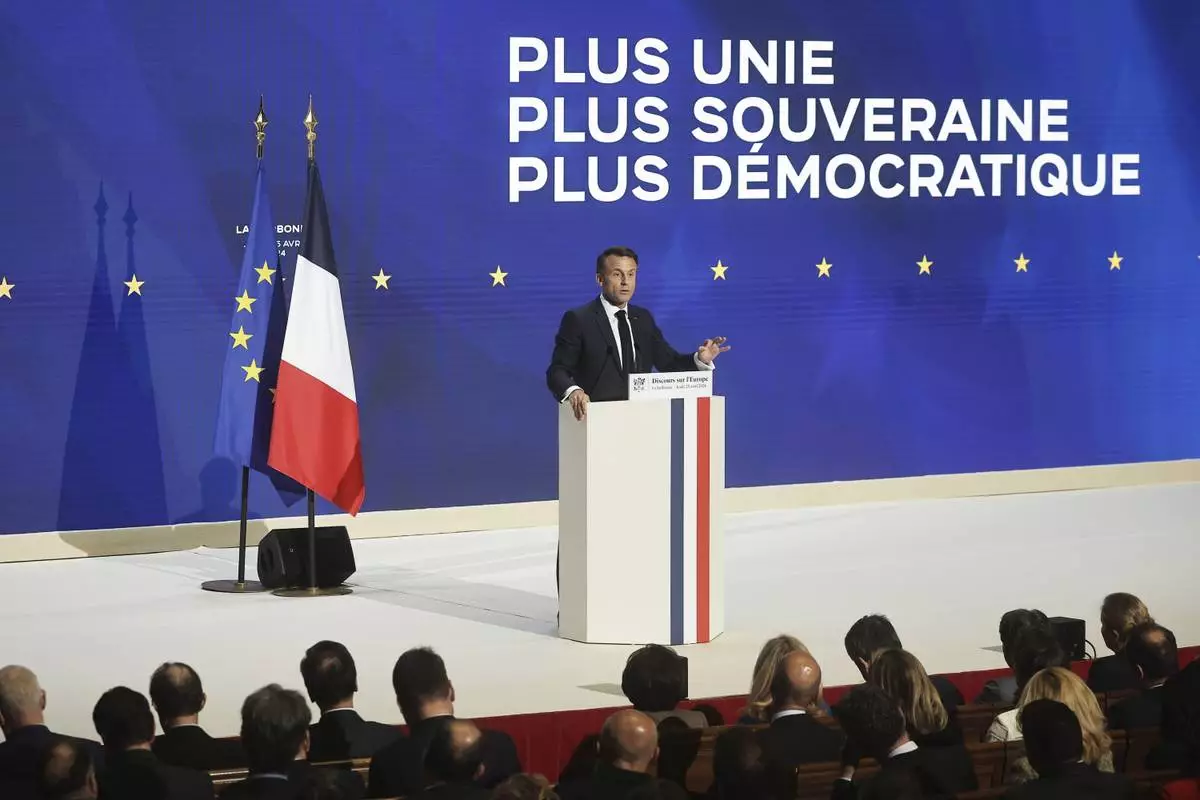
French President Emmanuel Macron delivers a speech on Europe in the amphitheater of the Sorbonne University, Thursday, April 25 in Paris. 2024. French President Emmanuel Macron will outline his vision for Europe as a more assertive global power at the backdrop of war in Ukraine, security, and economic challenges in a speech ahead of pivotal election for the European Parliament in June. (Christophe Petit Tesson, Pool via AP)
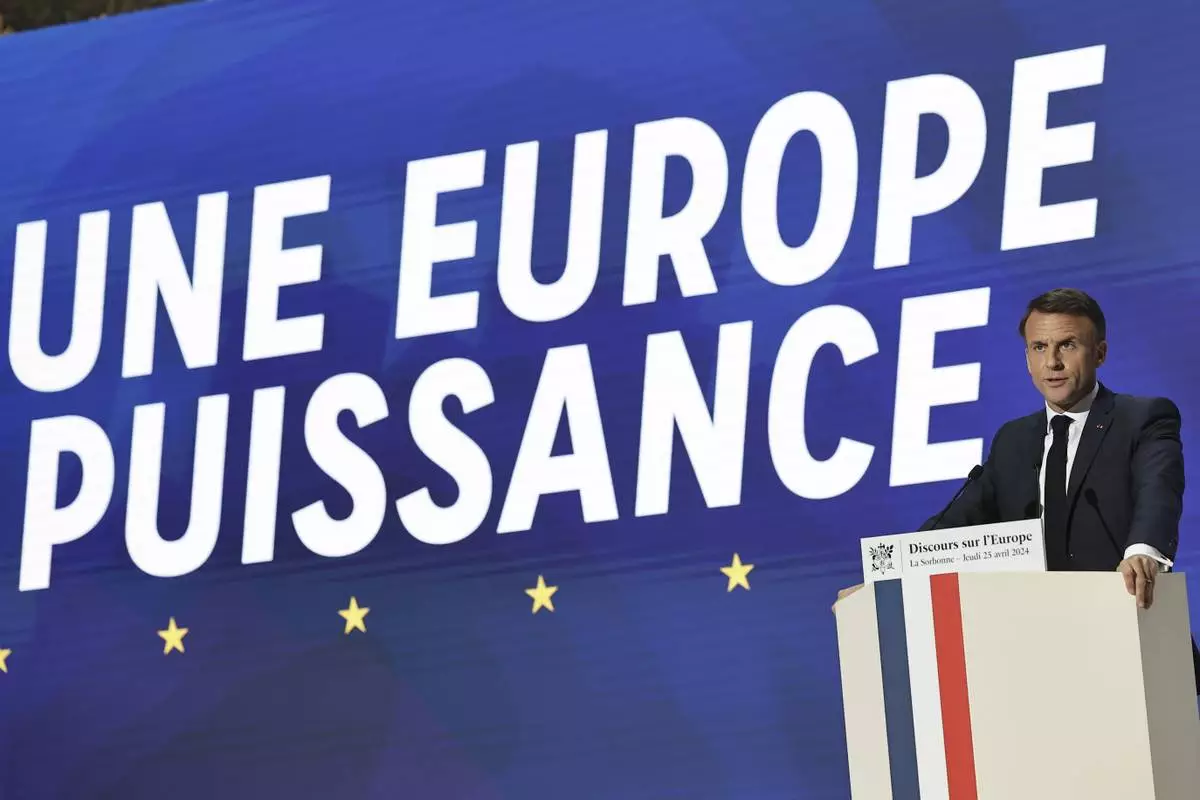
French President Emmanuel Macron delivers a speech on Europe in the amphitheater of the Sorbonne University, Thursday, April 25 in Paris. 2024. French President Emmanuel Macron will outline his vision for Europe as a more assertive global power at the backdrop of war in Ukraine, security, and economic challenges in a speech ahead of pivotal election for the European Parliament in June. (Christophe Petit Tesson, Pool via AP)
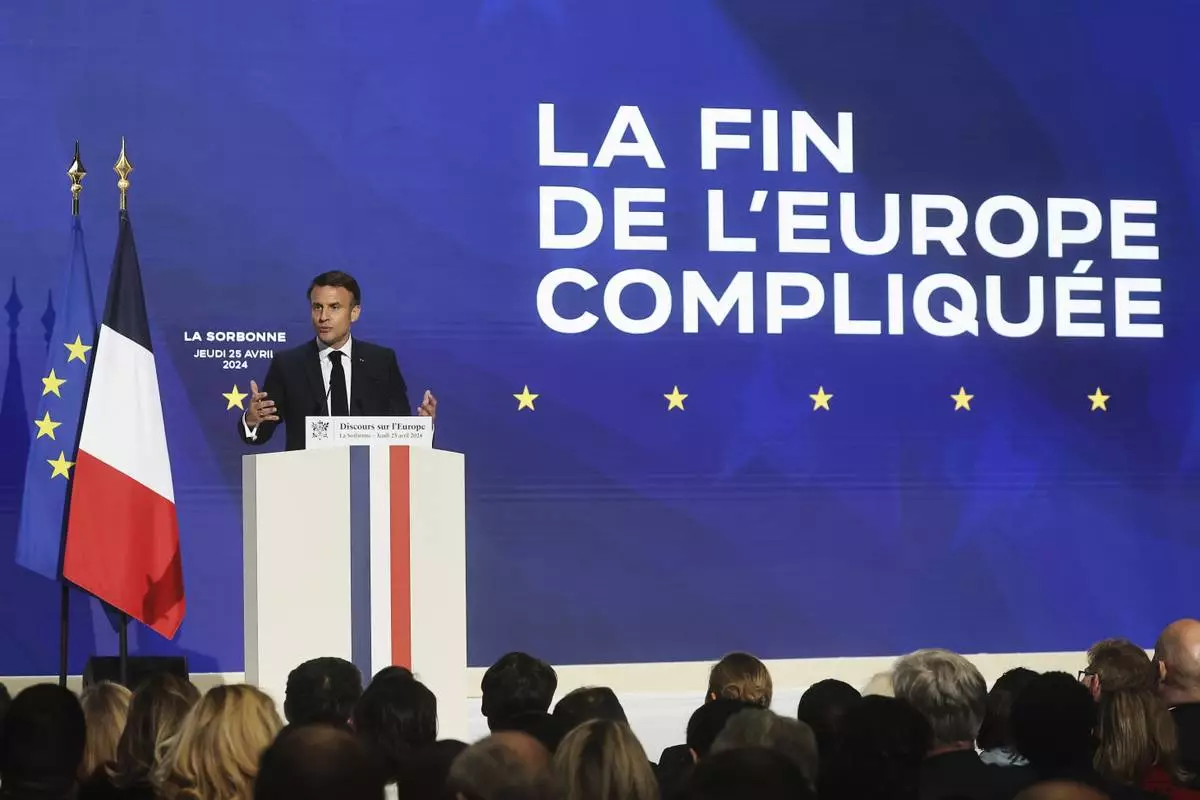
French President Emmanuel Macron delivers a speech on Europe in the amphitheater of the Sorbonne University, Thursday, April 25 in Paris. 2024. French President Emmanuel Macron will outline his vision for Europe as a more assertive global power at the backdrop of war in Ukraine, security, and economic challenges in a speech ahead of pivotal election for the European Parliament in June. (Christophe Petit Tesson, Pool via AP)
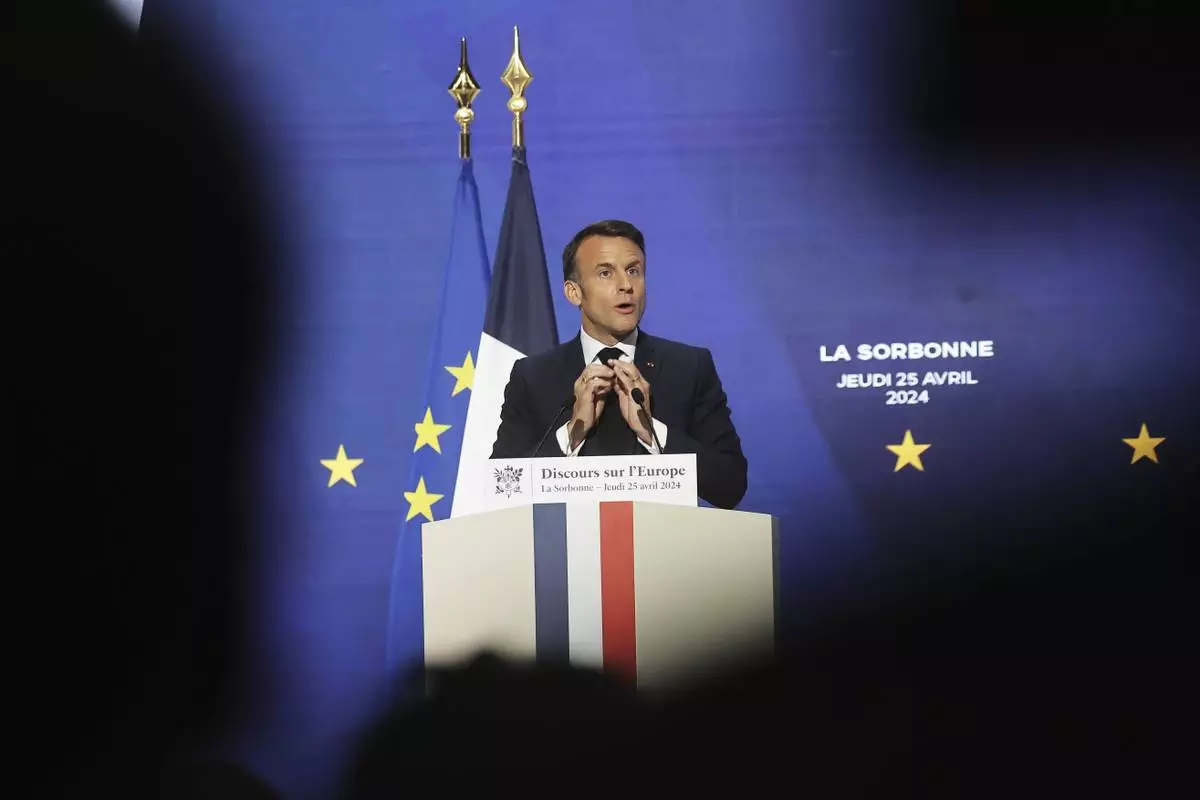
French President Emmanuel Macron delivers a speech on Europe in the amphitheater of the Sorbonne University, Thursday, April 25 in Paris. 2024. French President Emmanuel Macron will outline his vision for Europe as a more assertive global power at the backdrop of war in Ukraine, security, and economic challenges in a speech ahead of pivotal election for the European Parliament in June. (Christophe Petit Tesson, Pool via AP)
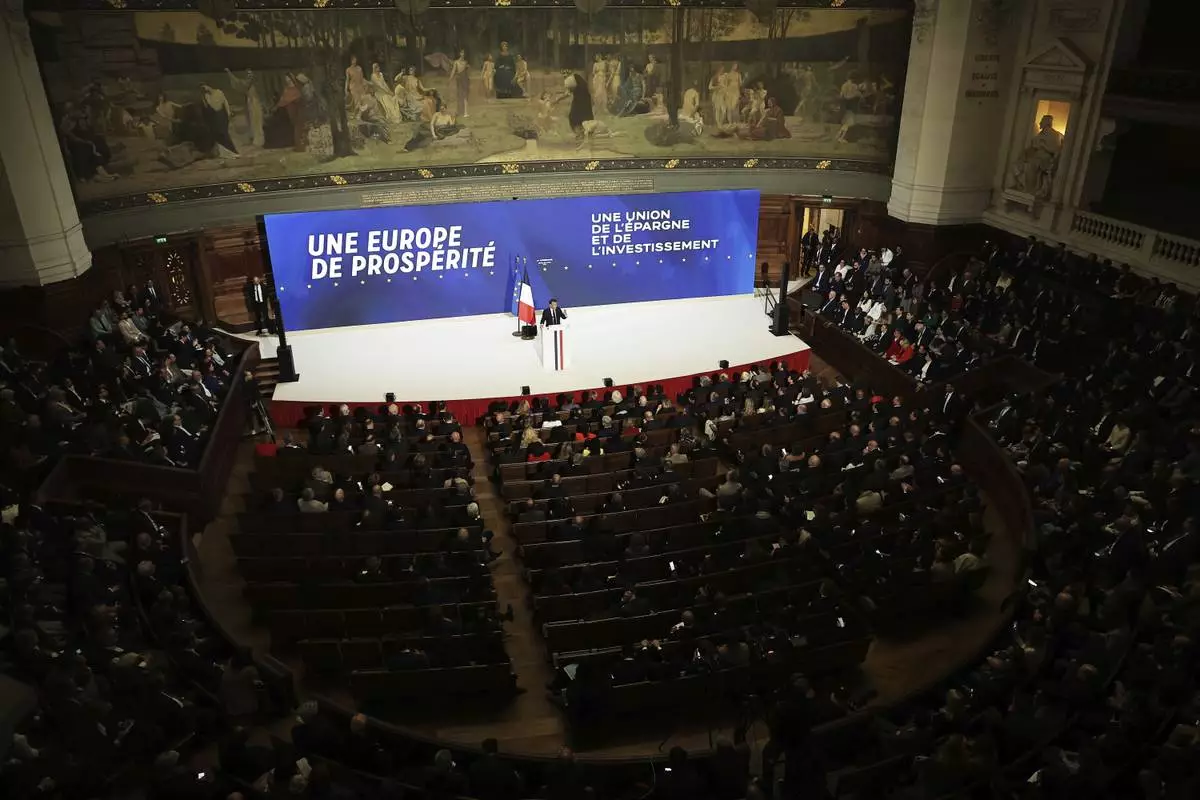
French President Emmanuel Macron delivers a speech on Europe in the amphitheater of the Sorbonne University, Thursday, April 25 in Paris. 2024. French President Emmanuel Macron will outline his vision for Europe as a more assertive global power at the backdrop of war in Ukraine, security, and economic challenges in a speech ahead of pivotal election for the European Parliament in June. (Christophe Petit Tesson, Pool via AP)
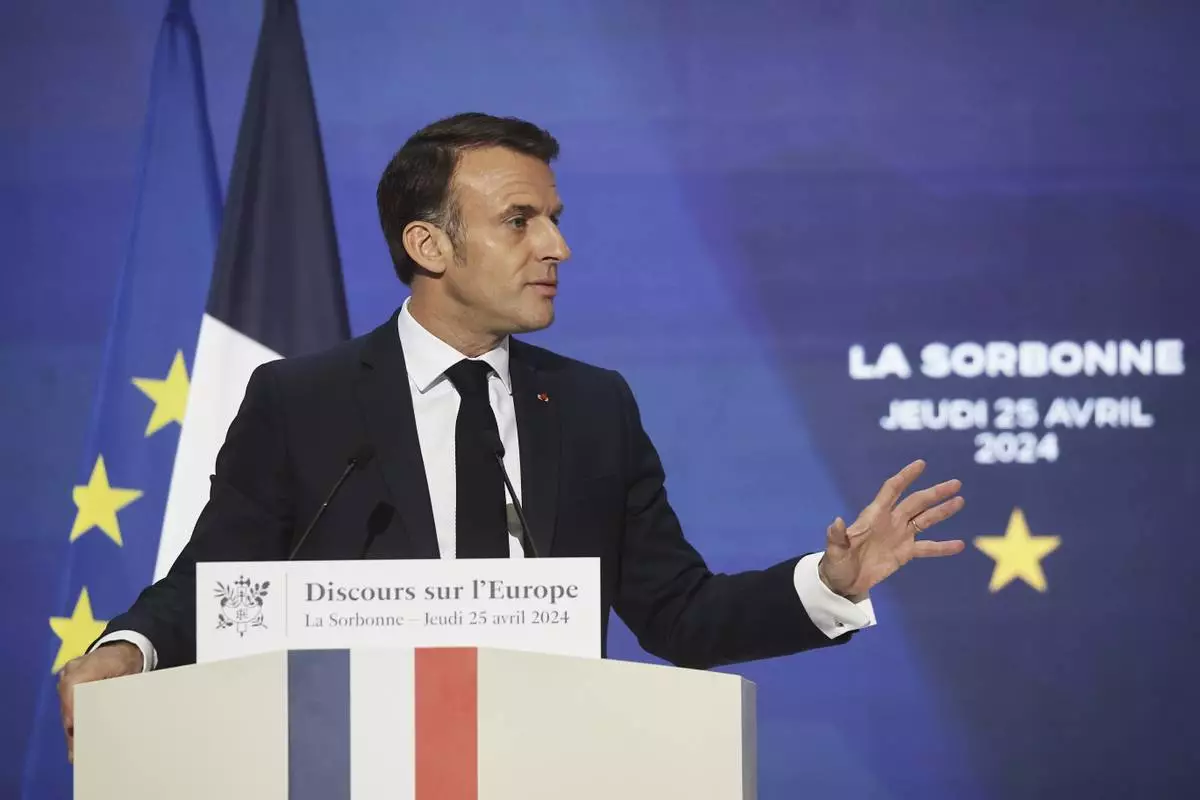
French President Emmanuel Macron delivers a speech on Europe in the amphitheater of the Sorbonne University, Thursday, April 25 in Paris. 2024. French President Emmanuel Macron will outline his vision for Europe as a more assertive global power at the backdrop of war in Ukraine, security, and economic challenges in a speech ahead of pivotal election for the European Parliament in June. (Christophe Petit Tesson, Pool via AP)
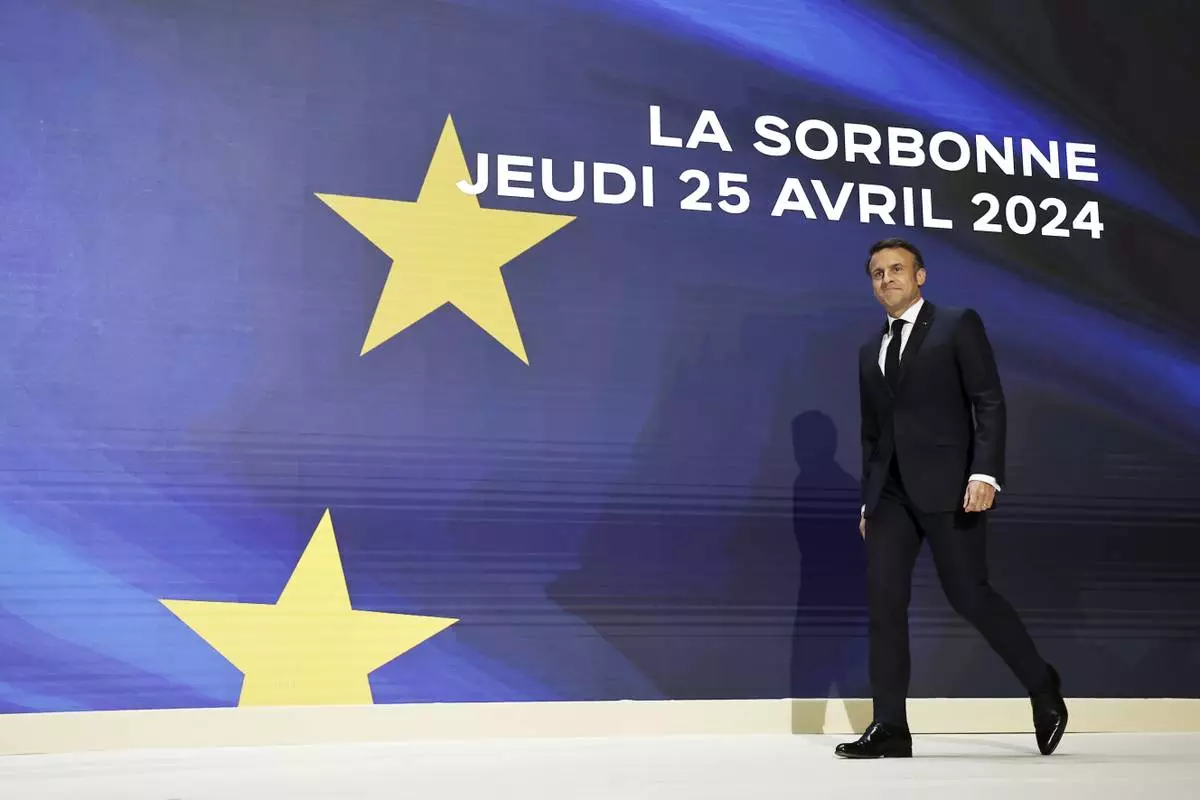
French President Emmanuel Macron arrives to deliver a speech on Europe in the amphitheater of the Sorbonne University, Thursday, April 25 in Paris. 2024. French President Emmanuel Macron will outline his vision for Europe as a more assertive global power at the backdrop of war in Ukraine, security, and economic challenges in a speech ahead of pivotal election for the European Parliament in June. (Christophe Petit Tesson, Pool via AP)
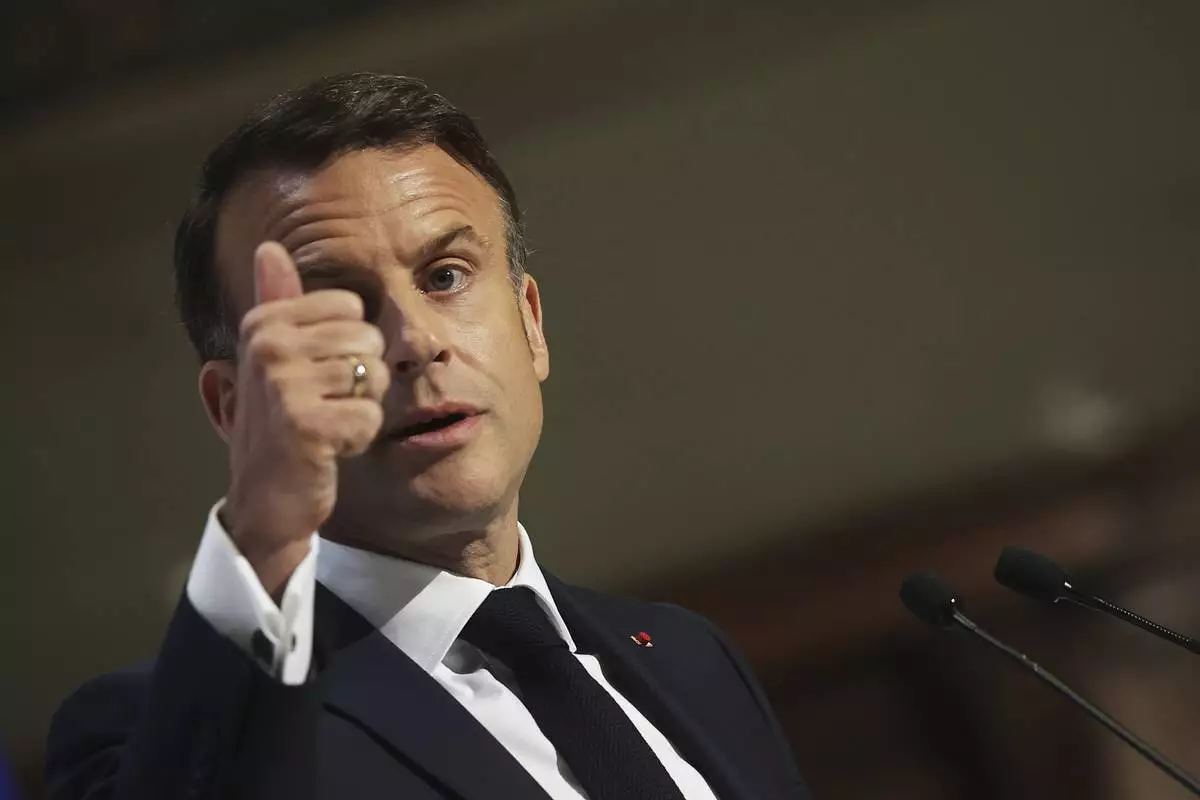
French President Emmanuel Macron delivers a speech on Europe in the amphitheater of the Sorbonne University, Thursday, April 25 in Paris. 2024. French President Emmanuel Macron will outline his vision for Europe as a more assertive global power at the backdrop of war in Ukraine, security, and economic challenges in a speech ahead of pivotal election for the European Parliament in June. (Christophe Petit Tesson, Pool via AP)
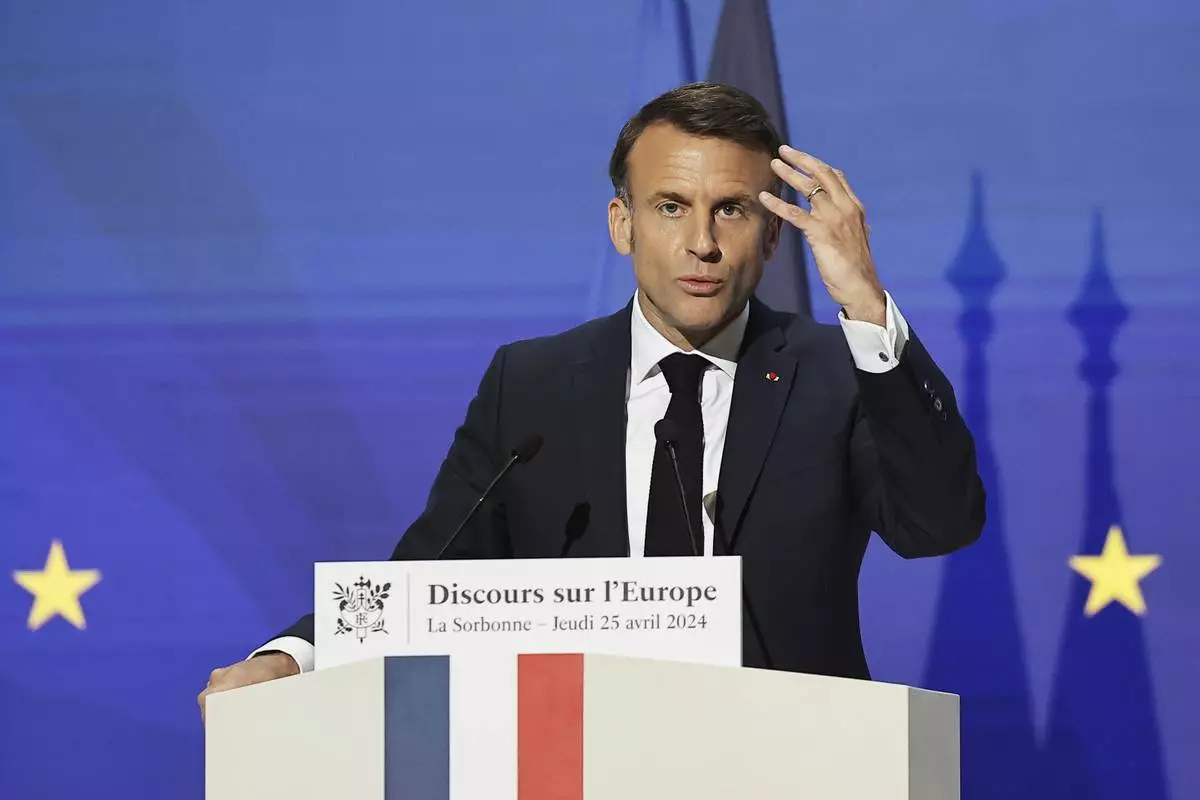
French President Emmanuel Macron delivers a speech on Europe in the amphitheater of the Sorbonne University, Thursday, April 25 in Paris. 2024. French President Emmanuel Macron will outline his vision for Europe as a more assertive global power at the backdrop of war in Ukraine, security, and economic challenges in a speech ahead of pivotal election for the European Parliament in June. (Christophe Petit Tesson, Pool via AP)
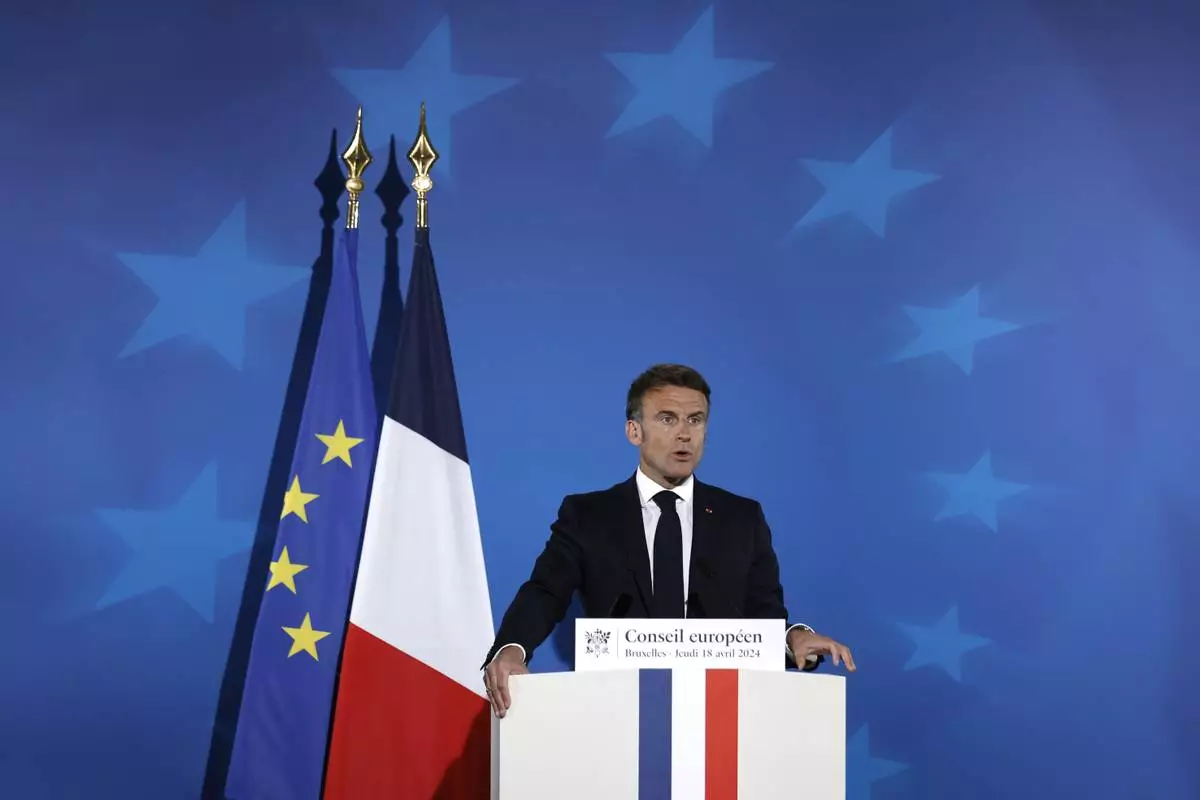
French President Emmanuel Macron speaks during a media conference at an EU summit in Brussels, Thursday, April 18, 2024. European Union leaders on Wednesday debated a new "European Competitiveness Deal" aimed at helping the 27-nation bloc close the gap with Chinese and American rivals amid fears the region's industries will otherwise be left behind for good. (AP Photo/Omar Havana)
























